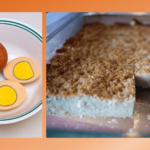Kubbeh, also known as kibbeh, kobeba, and any number of other variations, is less a food than a class of foods. It encompasses a whole host of different dishes that are mostly related to each other, but still very different. All are very beloved to the people who eat them, and while some types are strongly associated with Jews, others are completely not Jewish at all. I’ll attempt here, in a relatively concise manner, to summarize this collection of foods.
Categorizing Kubbeh, Kibbeh, etc.
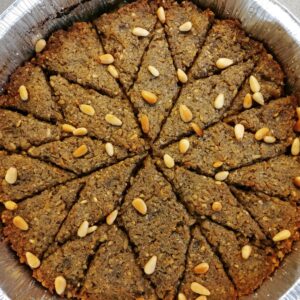
One way of categorizing types of kubbeh is via the preparation method. A common variety is fried, and shaped largely like an American football — slightly oblong with pointy ends. It is commonly called kibbe nabelsiah, matfuna, or machshi. A second is soft, rather than crispy, and is cooked within a host of different types of soup. This type, more commonly referred to using the kubbeh title and often named for the ingredients of the soup itself, is typically ball shaped (as in the main picture above), or flattened into a bulging disc. A third variety, kubbeh bil siniye, oven-bakes the kubbeh as a flat pie of sorts, rather than frying it or stewing it. (“Bil siniye” means “on a tray,” and references the round tray on which it is baked.) Finally, there are also some outlier types, found in single versions. For example, one type called kibbe nayyeh is served raw (more on that shortly), while another (kibbeh mishwiyeh) is cooked on a grill.
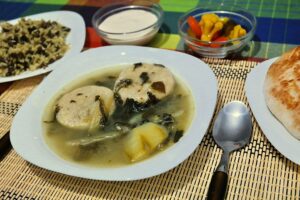
Similarly, while the meat inside is typically finely ground, at least one variety I know, made here in Jerusalem, uses a slow-cooked, pulled rib meat, referred to as siske. Some prefer to use lamb meat (probably a more traditional filling), others use beef or veal, a mix of different meats is not uncommon, and other options (potentially very modern) stuff the kubbeh with either fish or a vegetarian filling, such as mushrooms.
Specific Kubbeh Varieties
Aleppo, Syria is known for the numerous types of kibbeh available there. I doubt anyone has a comprehensive answer as to exactly how many types, because it definitely depends on your definitions of what makes one variety different from another. But in various places, I have seen claims that you can find 17, 60, or even 70 different varieties in that city. Suffice it to say, there are a lot!
The soup variety, most familiar from Iraqi Kurdistan, have numerous “types” based on the different soups. (Beyond that, the kubbeh themselves are usually similar.) Broadly, the soups are known either as hamud — sour — or hulao — sweet, or more accurately, not sour. Popular soups are adumah (red), bamia (okra), and hamousta (yellow and sour). A version called kubbeh chamu is made in a yellow, but less sour soup, and features much larger, disc-shaped kubbeh. It’s dough typically mixes both semolina and fine bulgur. I have been told that this type originated in Jerusalem, near Machane Yehuda market, but I have not been able to confirm that.
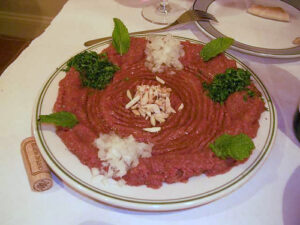
The previously mentioned kibbeh nayyeh is the greatest outlier in the category, not only because it is made of raw meat with no cooking method at all. Additionally, it does not encase the meat in a grain exterior. Rather, the meat is chopped extremely finely into a paste that also contains fine bulgur. It may be pounded, rather than minced or ground, but it essentially is like a Middle Eastern version of steak tartare. Since it is raw, and thus requires the meat to be extremely fresh, it is seen as a highly elevated dish that will be prepared only for very honored guests.
And if you wonder how this last dish came to be included in the category of kubbehs if it contains no exterior, I must point out that in most kubbeh varieties, the exterior is not purely grain. It is typically mixed with some proportion of meat to make a paste that holds its shape better without falling to bits. So conceivably, kibbeh nayyeh grew out of the production process of making kibbeh nabelsiah, just separating out that paste from the start, instead of proceeding all the way through the process. Or something like that.
What’s in a Name?
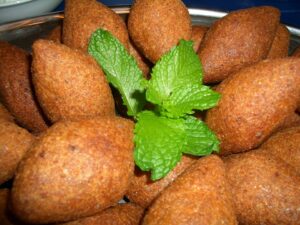
Roden states that the differences are merely location-based. To my mind, the differentiation might rely more on the specific type of kubbeh. But it does not necessarily have to be one or the other, as different types are certainly more common in different areas. So it might be both, to a degree. For example, the soup versions are more popular in Iraq and Kurdistan, and are more commonly called kubbeh. Does that mean that the kubbeh pronunciation is connected with the place, or the variety? Hard to say.
I have seen suggestions that the name derives from covering or hiding (related as you’ll see to the main forms of kubbeh which are essentially stuffed dumplings). But I’ve also seen suggestions that the name derives from a round or ball-like shape. Of course, as we’ll see, there are outliers within the kubbeh category that don’t cover anything and/or aren’t round in shape. One idea that slightly supports the shape-based origin is that the name(s) may also relate in some way to another familiar food of the region — kebab. In the Middle East, kebab specifically refers to ground, spiced meat, typically wrapped onto a skewer and grilled.
Suffice it to say, that there could be a good academic paper here for some interested linguist. But at the very least, we can gain some ideas of the classic characteristics of this food from its name.
How Jewish is Kubbeh?
There is no doubt that this is not an exclusively Jewish dish. The question is, how Jewish is it? It apears that the soup varieties are much more common among Jews, if not exclusively a Jewish dish. Some Kurdish Jews even put the soup-type kubbeh into their Shabbat stew (called mebosa).
Other types are definitely not Jewish, as they contain dairy products, which would be forbidden by traditional Jewish law in a meat dish such as kubbeh. Some versions from Syria contain clarified butter, or are served in either yogurt or labneh. Beyond that, many of the types made in Syria (where virtually no Jewish presence still remains) are not common or really known within the broader Jewish community. Examples include the grilled variety, and others that are stuffed with fruits. Considering that some see kibbeh as the national dish of Syria and Lebanon (these things are not official, of course), it makes sense that there would be varieties that only they eat. (Remember that Lebanon was not its own country before it was carved out of greater Syria in the 20th century. So the cuisines of these two countries overlaps heavily.)
Perhaps the most broadly eaten and widely recognized is the fried kibbeh torpedo. It is eaten by Jews and non-Jews alike, and has even reached places as far away as North and South America. It is the most easily recognized version, too. Even Assyrian Christians eat the bulgur-based product. So it crosses through the cuisines of all three religions in the region.
Most importantly, we all recognize how delicious this food-class is, and value the ability to prepare it and serve it to favored guests.


